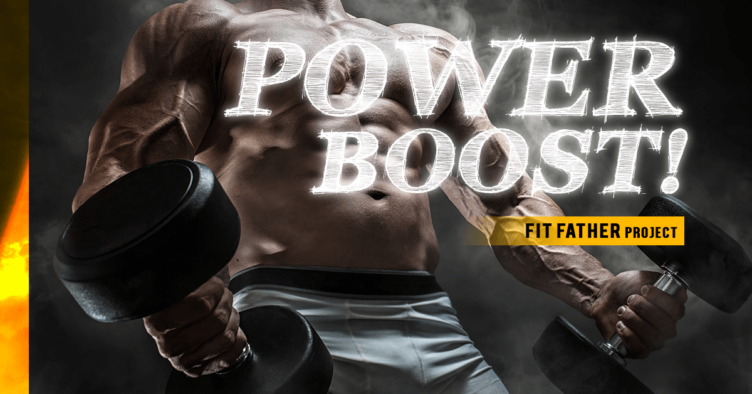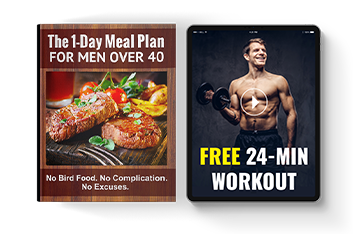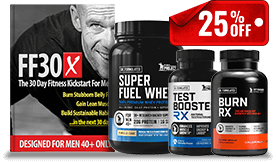Training for power is different from endurance training and other strength training workouts. The exercises you’ll complete utilize explosive movements that involve short energy bursts, such as:
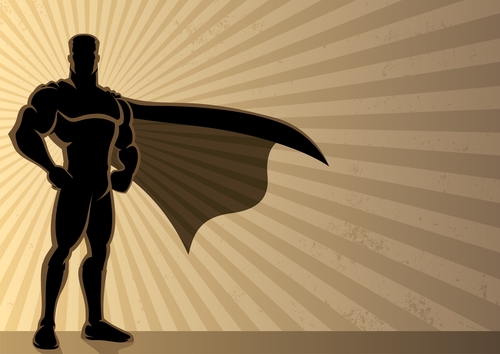
- Sprinting
- Jumping
- Exploding from a line
- Kicking
- Punching
- Throwing something
- Swinging something
- Making cuts while running
- Lifting something heavy quickly
- Hopping
- Bounding (leaping)
- Slamming something down
Knowing how to properly train and eat for power helps you improve athletic performance, and look and feel stronger.
Training for Power
When you’re training for power to increase strength and explosiveness, try compound exercises that work all of the major muscle groups, including your:
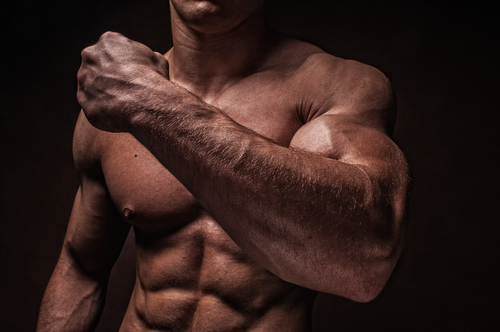
- Hamstrings,
- Quadriceps
- Glutes
- Calves
- Chest
- Back
- Shoulders
- Biceps
- Triceps
- Abs
Compound exercises work more than one major muscle group at a time to maximize strength in short time periods.
Examples of Power Exercises for Men
Having numerous explosive power exercises to choose from steers you in the right direction when increasing strength and power is your goal. For many of the power exercises below, you have the option of using weights or simply your own body weight as resistance. You might try adding weight after lifting just your body weight becomes easy.
Aim to complete 3 to 6 sets of 6 to 12 repetitions when you’re lifting heavy weights, or perform 30- to 60-second bouts during each plyometrics exercise you choose from below:
1. Jump Squats
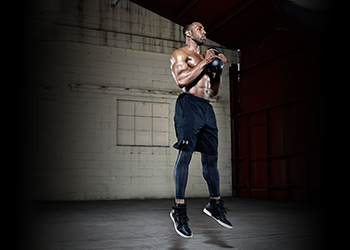 Jump Squats help increase explosive power in your lower body, and tighten and tone major lower body muscle groups, including your quads, glutes, and calves.
Jump Squats help increase explosive power in your lower body, and tighten and tone major lower body muscle groups, including your quads, glutes, and calves.
To complete a jump squat, begin with your feet slightly wider than shoulder width apart. Explosively jump up into the air (using your arms as momentum), and land softly. Squat down and jump back up in the air continuously for about 30 to 60 seconds. Rest for about 30 to 60 seconds, and repeat the exercise for a total of at least three sets.
To change things up a bit and work different muscles, alternate between wide-stance jump squats and narrow stance jump squats. Once you’re able to complete this exercise using just your own body weight with ease, try holding light dumbbell weights or wearing a weighted vest while jump squatting. Gradually increase weight the stronger you become.
2. Burpees
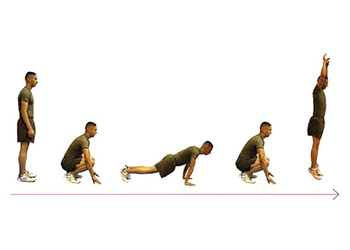 Burpees are power exercises that work your entire body, including your lower body, abs, chest, and arms. To complete burpees, squat and jump up into the air as high as you can. When you land, immediately get into a plank position to complete a push-up. Then explosively move your feet toward your hands to complete another jump.
Burpees are power exercises that work your entire body, including your lower body, abs, chest, and arms. To complete burpees, squat and jump up into the air as high as you can. When you land, immediately get into a plank position to complete a push-up. Then explosively move your feet toward your hands to complete another jump.
Continue to alternate between a jump, a plank, and a push-up to complete burpees for 30 to 60 seconds. Wear a weighted vest while doing burpees when you become more advanced and need added resistance.
3. Plyometrics Push-ups
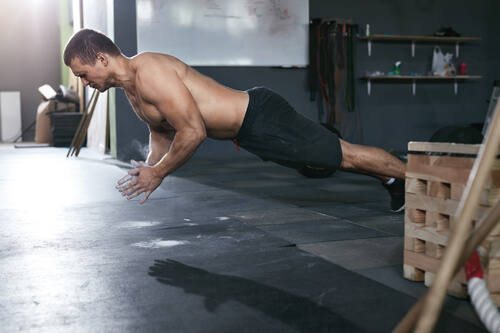 Push-ups should be a part of any power workout for men. Normal push-ups help boost strength and power, but plyometrics push-ups are especially useful when you want to increase upper body power and explosiveness.
Push-ups should be a part of any power workout for men. Normal push-ups help boost strength and power, but plyometrics push-ups are especially useful when you want to increase upper body power and explosiveness.
To complete a plyo push-up, simply lower your body down into a low plank position, and instead of doing a regular push-up, explosively push your upper body up until your hands become airborne.
When you become advanced enough, try clapping your hands together during plyo push-ups.
4. Jumping Lunges
 There are two ways to complete power-boosting jumping lunges to increase lower body strength and explosiveness. Simply step forward with your right leg into a lunge position, and jump up and down while maintaining the lunge pose. Do this continuously for about 30 to 60 seconds, and switch legs.
There are two ways to complete power-boosting jumping lunges to increase lower body strength and explosiveness. Simply step forward with your right leg into a lunge position, and jump up and down while maintaining the lunge pose. Do this continuously for about 30 to 60 seconds, and switch legs.
Another option is to alternate legs during jumping lunges. During this exercise, you'll switch legs each time you jump up and down (while maintaining the lunge pose).
5. Kettle Bell Swings
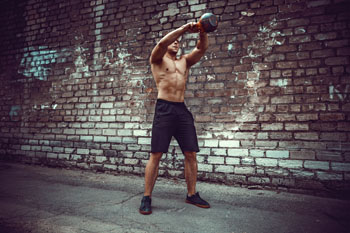 To complete kettle bell swings, hold a kettle bell with both hands in front of your body with your arms hanging down. Stand with your feet slightly wider than shoulder width apart, and squat down until your kettle almost touches the floor.
To complete kettle bell swings, hold a kettle bell with both hands in front of your body with your arms hanging down. Stand with your feet slightly wider than shoulder width apart, and squat down until your kettle almost touches the floor.
Then explosively swing the kettle bell upward, keeping your arms straight, until your arms are at least parallel with the floor. Continue on with squats and swings for 6 to 12 reps (or a 30- to 60-second bout), depending on how heavy your kettle bell is. The heavier your weight, the fewer reps you'll be able to complete using correct form.
6. Medicine Ball Slams
To complete medicine ball slams, you’ll need a medicine ball that’s heavy enough to create resistance but light enough to lift over your head. Begin with the ball on the ground, while you’re in a squat position. Grab the medicine ball and lift it above your head while rising from a squat position.
Once you’re in a standing position, forcefully slam the ball down on the ground as hard as you can, and repeat the exercise for at least 30 to 60 seconds.
7. Wall Ball Squats
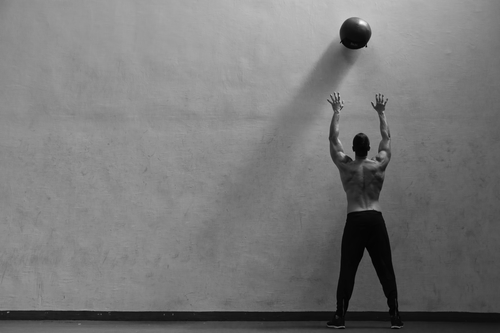 Another power exercise that strengthens your lower body, upper body, and core is called wall ball squats. During this power workout, you’ll hold a medicine ball at your chest and stand next to a sturdy wall.
Another power exercise that strengthens your lower body, upper body, and core is called wall ball squats. During this power workout, you’ll hold a medicine ball at your chest and stand next to a sturdy wall.
Simply squat down with the ball at your chest. When you push your body back up, throw the medicine ball with both hands as high as you can against the wall. Catch the ball and squat back down to repeat the exercise.
8. Box Jumps
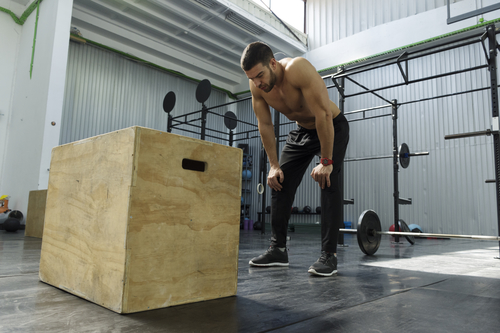 You’ll need a plyometrics box to complete box jump exercises. In fact, any type of study box or bench does the trick. Using your arms as momentum, jump onto the box or bench and land on both feet simultaneously.
You’ll need a plyometrics box to complete box jump exercises. In fact, any type of study box or bench does the trick. Using your arms as momentum, jump onto the box or bench and land on both feet simultaneously.
Step or jump down onto the ground (landing softly), and repeat additional box jumps until fatigue sets in. Aim to do this exercise for at least 30 seconds.
9. Sled Pushes
You don’t have to use a weighted workout sled to complete sled push exercises. Simply find a large free weight that’s fairly smooth and flat, and slides well on the ground. Bend down and push the weight forward on the floor as fast as you can for about 30 to 50 yards. Rest, and repeat the exercise at least 4 to 6 times.
10. Chin-Ups
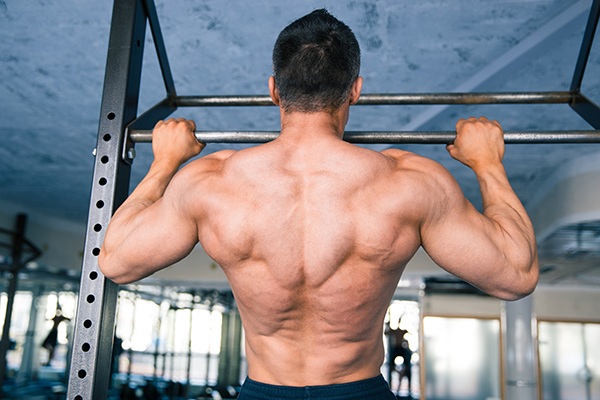 You’ll need a chin-up bar to do chin ups, but this exercise is excellent for boosting upper body power and strength. Simply hold the bar tightly with both hands, pull yourself up as fast as you can until your chin is above the bar, lower your body back down, and repeat the exercise as many times as you can. Aim for 6 to 12 reps, or do as many chin-ups as you can in 30 to 60 seconds.
You’ll need a chin-up bar to do chin ups, but this exercise is excellent for boosting upper body power and strength. Simply hold the bar tightly with both hands, pull yourself up as fast as you can until your chin is above the bar, lower your body back down, and repeat the exercise as many times as you can. Aim for 6 to 12 reps, or do as many chin-ups as you can in 30 to 60 seconds.
11. Push Presses
Use a barbell or dumbbells to complete power-boosting push presses. Hold your barbell or dumbbells near your chest and quickly squat down slightly. Then explosively push the weights up toward the ceiling until your arms are fully extended. Place the weights back at your chest and repeat the exercise.
12. Sprints
 Sprinting is one of the best ways to increase power and strength. You can practice sprinting in your backyard, at a track, or in your neighborhood. Simply sprint as fast as you can for 50 to 100 yards, using your arms as added momentum. Take a short 30- to 60-minute rest period, and repeat about 4 to 6 times.
Sprinting is one of the best ways to increase power and strength. You can practice sprinting in your backyard, at a track, or in your neighborhood. Simply sprint as fast as you can for 50 to 100 yards, using your arms as added momentum. Take a short 30- to 60-minute rest period, and repeat about 4 to 6 times.
13. Snatches
The snatch is a power exercise that works your entire body, and really gets your heart pumping. Simply complete a dead lift using a barbell, and immediately push the barbell above your head until your arms are fully extended.
With the barbell still overhead, dip down into a deep squat, stand up from the squat, and move on to another dead lift. Repeat these movements continuously at least 6 to 12 times (or 30 to 60 seconds), and aim for 3 to 6 sets total.
14. Power Cleans
Power cleans are similar to snatches. You’ll complete a dead lift while holding a barbell (or dumbbells if that’s what you have handy), explosively bring the bar to your chest, do a squat with the weight still at your chest, and complete another dead lift. Do this continuously for about 6 to 12 times (or 30 to 60 seconds), and complete 3 to 6 sets of power cleans.
15. Tuck Jumps
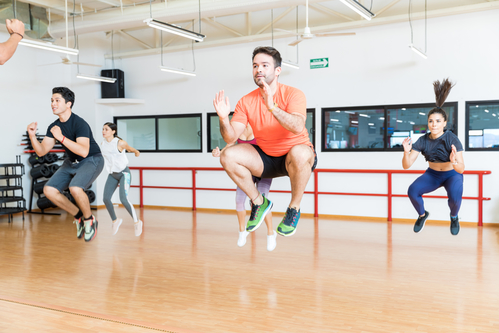 Tuck jumps are similar to squat jumps. You’ll begin with your feet slightly wider than shoulder width apart. Jump up as high as you can, using your arms as momentum.
Tuck jumps are similar to squat jumps. You’ll begin with your feet slightly wider than shoulder width apart. Jump up as high as you can, using your arms as momentum.
When you’re at the highest point in your jump, tuck your knees toward your chest and land softly on the ground.
Repeat tuck jumps continuously 6 to 12 times (or for at least 30 seconds), and complete 3 to 6 sets.
Creating a Power Workout for Men
There are several ways you can create your own power workout for men at home using the exercises above. Simply pick several compound exercises from the list and begin.
Complete 3 to 6 sets of 6 to 12 repetitions, or 30- to 60-second bouts for each power exercise you choose. Rest for 30 to 60 seconds (or longer if you’re lifting heavy loads) between sets.
If you’re circuit training, work in some endurance exercises between power moves, such as:
- Jogging in place
- Jumping jacks
- Rope jumping
- Cycling
- Rowing
- Walking
- Mountain climbers
- Side to side shuffles
- Side to side jumping
- Plank jacks
If you’re at a loss when it comes to creating your own power training workout, sign up for Fit Father Project’s free 1-day workout plan to get started.
Eating for Power
Eating for power enhances your physique, improves athletic performance, and gives you an extra boost of energy. Eat often throughout the day, about every few hours or so, and aim for six small or medium-sized meals instead of just a few large meals.
Calories
The number of calories you’ll require daily depends on your usual intake, how active you are, and your weight management goals. The Dietary Guidelines for Americans 2020 recommend active adult men take in 2,600 to 3,000 calories a day to maintain their weights.
Protein
Aim to eat about 1 gram of protein per pound of your body weight, or about 20 to 40 grams at each meal, recommends the Journal of the International Society of Sports Nutrition. Choose protein-rich:
- Lean meats
- Chicken
- Turkey
- Fish
- Seafood
- Eggs
- Tofu
- Low-fat dairy foods
- Protein powder shakes
- Legumes
- Nuts
- Seeds
Aim to eat a protein-rich food at each meal or snack.
Carbohydrates
Be sure to include plenty of carb-rich foods at meal time to keep energy levels soaring, especially during power workouts. Athletes need about 2 to 3 grams of carbohydrates per pound of body weight daily. Fiber-rich starches include:
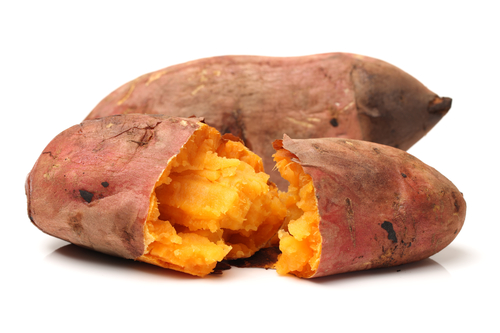
- Sweet potatoes
- Corn
- Peas
- Black beans
- Other legumes
- Quinoa
- Brown rice
- Wild rice
- Oatmeal
- Whole grain cereals
- Whole grain Ezekiel bread
Aim to fill about half of each plate with fruits and vegetables, and one-fourth of your plate with fiber-rich starches from the list above.
Dietary Fat
You'll use dietary fat for just about every structure and function within the body. About 25 to 30 percent of your calories should be from fat, and fat provides 9 calories per gram. Choose heart healthy fats, such as:
- Avocados
- Fish oil
- Vegetable oils
- Other plant-based oils
- Nuts
- Seeds
- Nut butters
- Olives
Aim to eat at least one healthy fat at each meal. This might be as simple as cooking with oils, or topping salads with avocados, nuts, or seeds.
Beginning a New Power Workout for Men
 Aim to complete a power workout for men at least one to three times each week to maximize results. When you’re first starting out, use lighter weights or complete fewer sets or reps. Gradually increase resistance and the number of times weekly you complete power workouts.
Aim to complete a power workout for men at least one to three times each week to maximize results. When you’re first starting out, use lighter weights or complete fewer sets or reps. Gradually increase resistance and the number of times weekly you complete power workouts.
Alternate between doing power workouts, high-intensity interval training, continuous cardiovascular exercise, traditional strength training, and circuit training. In other words, avoid doing the same workout two days in a row and change up workouts often.
The key to achieving the physique and fitness level you desire is to:
- Vary your workouts
- Eat healthy foods
- Get plenty of sleep
- Keep stress levels low
- Go outside
Here at FFP we've helped thousands of men find success. Read a few our testimonials and hear out story to see how we can help you.
Sign up for our newsletter and check out our free muscle building workout to get started shaping your future today.
What Are The 5 Best Muscle Building Exercises For Men 40+?
The secret to building age-defying muscle in your in 40s, 50s, & 60s is to modify the best muscle building exercises (bench, squats, rows) to make them safe on your joints…
Erin Coleman, B.S. Nutritional Science, R.D., L.D.
Writer, Fit Father Project
Erin Coleman is a registered and licensed dietitian with over 15 years of freelance writing experience.
She graduated with her Bachelor of Science degree in nutritional science from the University of Wisconsin-Madison, and completed her dietetic internship at Viterbo University in La Crosse, Wisconsin.
Prior to beginning her career in medical content writing, Erin worked as Health Educator for the University of Wisconsin-Madison Department of Internal Medicine.
Her published work appears on hundreds of health and fitness websites, and she’s currently working on publishing her first book! Erin is a wife, and a Mom to two beautiful children.
Here’s How Busy Guys 40+ Are Building Age-Defying Muscle And Strength… Working Out Just 3 Hours Per Week...
This proven "Old School Muscle Program For Guys 40+" combines the “old school” bodybuilding secrets with the “new school” science… to produce muscle & strength building results fast.
Only for guys 40+ who want to build muscle.
If you're frustrated with stubborn belly fat, failed diets, and time-consuming workouts, this is the answer you’ve been looking for…
- Old School Muscle (OSM) covers every aspect of building muscle for you as a guy 40+:
- The 9-Week Muscle Building Program – safe, joint-friendly exercises
- VIP Accountability Coaching – our Fit Father Team will personally walk you to success, step-by-step.

